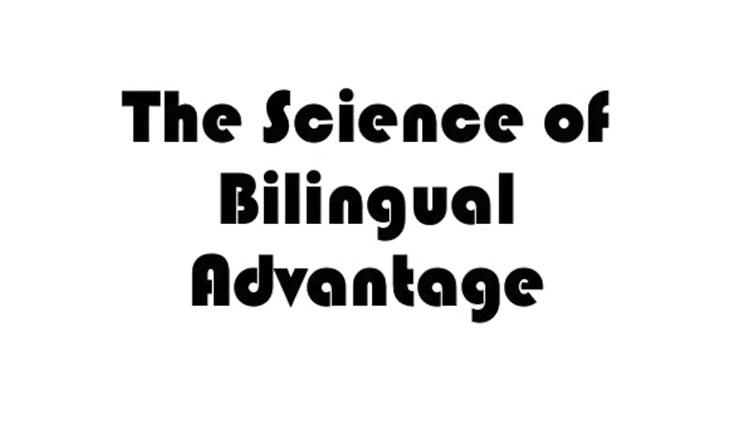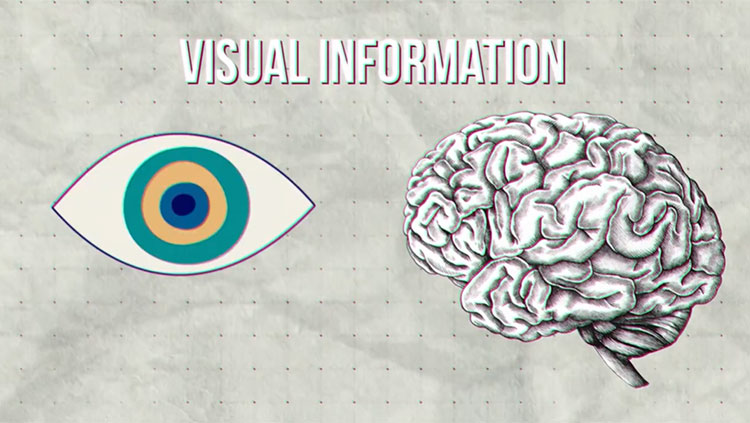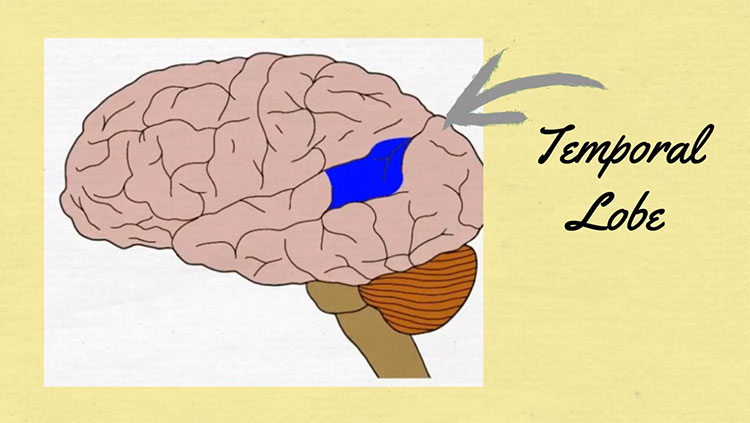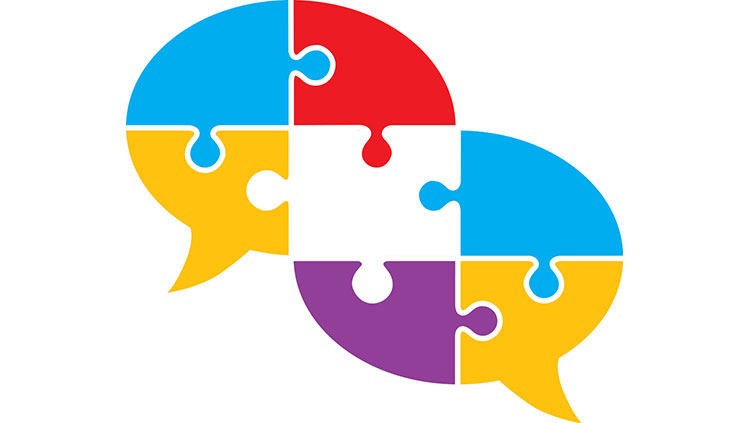What Ums and Uhs Reveal About Speech and the Brain
- Published5 Apr 2022
- Author Aishwarya Jagani
- Source BrainFacts/SfN

When neurologist Eishi Asano and his team at Wayne State University strapped electrodes onto the brains of their research volunteers, they asked them to describe what they saw while looking at a picture of a hippo swimming in a pool. Using the odd request, the team was hoping to pinpoint which parts of the brain were responsible for identifying and describing an image.
But something else caught their eye.
“During the experiment we found that some patients used some filler words like ‘um’ or ‘uh’, none of which don’t mean anything. So, we had a unique opportunity to see what happened in the brain during the utterance of such filler words,” said Asano.
Along with his team, Asano, a professor of pediatrics and of neurology, deployed electrocorticography (EcoG) and found that the association cortex and visual areas became active when patients used filler words. The association cortex, or association areas, resides on the surface (cortex) of the brain involved in integrating information from different brain regions. It aids in tasks like learning, remembering, thinking, and speaking. The visual cortex is a separate region of the brain’s surface that receives, integrates, and processes visual information.
Scientists have linked association areas to language because they activate when someone engages in a language task requiring high amounts of effort.
The results of Asano’s study indicated that ‘uh-s’ and ‘um-s’ might crop up when a person is scanning a visual scene or is struggling with a difficult speech task — like trying to find a less commonly used or difficult to pronounce word (or when describing a scene, like a hippo in a swimming pool).
Why Disfluencies Occur
The presence of filler words and other disfluencies like whole word and phrase repetitions, partial-word repetitions, and silent pauses may indicate to some people that the speaker is nervous about the conversation, or maybe even lying. However, the reasons for disfluencies in speech are more varied and complex.
Filler words show up in speech when the speaker is trying to find the right word for something. This could mean finding words to describe something unusual (like a pink hippo waltzing on a cloud) or trying to recall a word that isn’t a part of everyday vocabulary.
When Asano’s study participants uttered an ‘uh’ or an ‘um’, they appeared to be trying to “retrieve the optimal word to describe what they saw.” Disfluent non-native speakers, compared to native ones, are suggested to utter fillers more frequently during verbal communication, says Asano.
“For example, as a non-native English speaker, I use filler words more often when speaking English, my second language, than when I speak my first language, Japanese,” he said. “Considering that the association cortex supports word retrieval and short-term verbal memory, my association cortex network may be more active when I speak in English and have a hard time finding an appropriate phrase.”
Martin Corley, Professor of Speech, Language and Cognition at the University of Edinburgh, says, “If you present people with something which is harder to describe — like a picture that's not particularly clear or has no unique name compared to a picture that's quite easy to describe — they're more likely to be disfluent before describing the former.” But as you figure out what it is you want to say, your brain starts to shift gears.
“During the utterance of filler words, people may be searching for a correct answer and are still actively use their association or visual cortex. But when they are ready to verbalize a relevant answer, engagement of the association and visual areas subside because the necessary process has been completed,” says Asano.
This suggests that the association cortex is engaged when a person is struggling to find the right word — powering down when speech begins.
Disfluencies can come from the inability to ‘find the right word’ or from trouble with memory retrieval. But, they also may arise as unconscious pauses while trying to retrieve a word or as more deliberate attempts to hold the floor when speaking with others.
Intentional to Unconscious
Filler words are often used as a hedge: to soften a harsh message or make a refusal sound more polite.
“If you have to tell your best friend that they're not invited to a party, you might say, ‘Um, you're not invited’, and that might be an almost deliberate way to soften the message and slightly to disassociate yourself from the full message,” says Corley.
Another semi-intentional use of filler words is to provide a natural pause when talking about something complex — giving the listener(s) time to catch up and let the information sink in. Corley calls this “semi-voluntary disfluency” an example of “floor holding”. Referencing a 2002 study by Herbert H. Clark and Jean E. Fox Tree, he says they described it as “a signal indicating that I don't quite know what to say yet, but I'm not ready to give you the floor.”
While some experiments have indicated that often there can be an intentional component to the use of disfluencies, a study by Corley and others failed to establish disfluencies are always an intentional signal in dialogue.
A less intentional use of disfluencies occurs when a speaker unconsciously allows a listener time to process something complex.
“As speakers we are often aware [that] if we speak too complexly the listener might not understand. We use these items, pretty unconsciously, to help the person process what we are saying,” Michael Handford, a professor of applied linguistics and English language at Cardiff University, told The Independent.
Disfluencies occur for a variety of reasons, but usually provide crucial information about the preparedness, familiarity, and emotional state of the speaker.
CONTENT PROVIDED BY
BrainFacts/SfN
References
Arciuli, J., Mallard, D., & Villar, G. (2010). “Um, I can tell you're lying”: Linguistic markers of deception versus truth-telling in speech. Applied Psycholinguistics, 31(3), 397-411. doi:10.1017/S0142716410000044. Retrieved from https://www.researchgate.net/publication/232004872_Um_I_can_tell_you're_lying_Linguistic_markers_of_deception_versus_truth-telling_in_speech
Christenfeld, N. Does it hurt to say um? (1995). J Nonverbal Behav 19, 171–186. Retrieved from https://link.springer.com/article/10.1007/BF02175503
Clark H.H., Fox Tree J.E. (2002). Using uh and um in spontaneous speaking, Cognition, Volume 84, Issue 1, Pages 73-111, ISSN 0010-0277, doi: 10.1016/s0010-0277(02)00017-3. Retrieved from http://www.columbia.edu/~rmk7/HC/HC_Readings/Clark_Fox.pdf
Corley M., Hartsuiker R.J. (2011). Why Um Helps Auditory Word Recognition: The Temporal Delay Hypothesis. PLoS ONE 6(5): e19792. doi: 10.1371/journal.pone.0019792. Retrieved from https://journals.plos.org/plosone/article?id=10.1371/journal.pone.0019792
Craine, R. (2022). Stuttering. Ferri's Clinical Advisor 2022. 1429.e4-1429.e5. Elsevier. https://www.clinicalkey.com/#!/content/book/3-s2.0-B9780323755702008730.
Dance, A. (2020). The mysterious cause of stuttering in the brain. BBC. https://www.bbc.com/future/article/20200922-why-some-people-suffer-from-a-stutter
Dodgson, L. (2017). The psychological reasons why we use filler words like 'um' and 'you know' in conversations. Business Insider. https://www.businessinsider.com/psychological-reasons-we-use-filler-words-2017-4
Engelhardt P.E., McMullon M.E., Corley M. (2018). Individual differences in the production of disfluency: A latent variable analysis of memory ability and verbal intelligence. Q J Exp Psychol (Hove). 2019 May;72(5):1084-1101. doi: 10.1177/1747021818778752. Epub 2018 Jun 5. PMID: 29756526. Retrieved from http://homepages.ed.ac.uk/martinc/offprints/emc18.pdf
Corley M, Hartsuiker RJ (2011) Why Um Helps Auditory Word Recognition: The Temporal Delay Hypothesis. PLoS ONE 6(5): e19792. https://doi.org/10.1371/journal.pone.0019792 Retrieved from https://journals.plos.org/plosone/article?id=10.1371/journal.pone.0019792
Herbert H. Clark, Jean E. Fox Tree, Using uh and um in spontaneous speaking, Cognition, Volume 84, Issue 1, 2002, Pages 73-111, ISSN 0010-0277, from http://www.columbia.edu/~rmk7/HC/HC_Readings/Clark_Fox.pdf
Finlayson, I.R., Corley, M. (2012). Disfluency in dialogue: an intentional signal from the speaker? . Psychon Bull Rev 19, 921–928. doi: 10.3758/s13423-012-0279-x. Retrieved (2012). https://doi.org/10.3758/s13423-012-0279-x from http://homepages.ed.ac.uk/martinc/offprints/fc12.pdf
Kalia, S. (2021). Science Backs People Who Use Filler Words Like ‘Um’ And ‘You Know’. The Swaddle. https://theswaddle.com/filler-words-um-you-know/
Onion, A. (2006). Psychologists Say 'Um' and 'Uh' Have Meaning. ABC News. https://abcnews.go.com/Technology/story?id=97983&page=1
Orena, A.J. (2021). Disfluencies can shed light about what’s going on in the brain as we speak. Massive Science. https://massivesci.com/articles/speech-disfluency-stutter-learning-brains-neuroscience/
Schafer, J. (2015). Um... Little Words Can Signal Big Lies... You Know. Psychology Today. https://www.psychologytoday.com/us/blog/let-their-words-do-the-talking/201512/um-little-words-can-signal-big-lies-you-know
Shapira, A. (2019). Why Filler Words Like “Um” and “Ah” Are Actually Useful. Harvard Business Review. https://hbr.org/2019/08/why-filler-words-like-um-and-ah-are-actually-useful
Sugiura, A., Alqatan, Z., Nakai, Y. et al. (2020). Neural dynamics during the vocalization of ‘uh’ or ‘um’. Sci Rep 10, 11987. Retrieved from https://www.nature.com/articles/s41598-020-68606-x
Vandette, K. (20javascript:void(0);18). Study finds that liars actively suppress tell-tale cues of deception. Earth.com. https://www.earth.com/news/sliars-suppress-deception-cues/
Watkins, K.E., Chesters, J., Connally, E.L. (2016). The Neurobiology of Developmental Stuttering. Neurobiology of Language. Chapter 79, pages 995-1004. Academic Press. https://doi.org/10.1016/B978-0-12-407794-2.00079-1.
(“Ums, Ahs,” n.d.) Ums, Ahs, And Filler Words: What Does The Research Actually Say? https://www.extempra.com/2019/06/03/ums-ahs-and-filler-words-what-does-the-research-actually-say/
Also In Language
Trending
Popular articles on BrainFacts.org


















